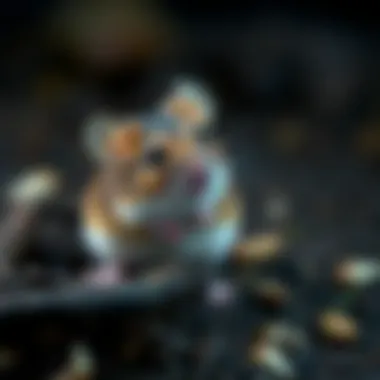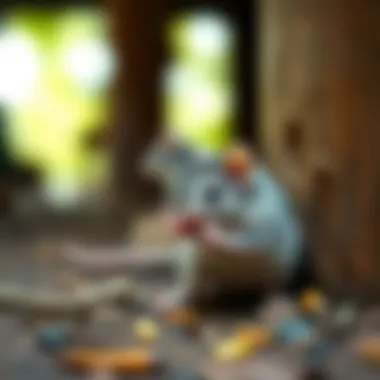Essential Techniques for Trapping Mice Effectively


Intro
Dealing with mice in your home can be a right pickle, leaving many homeowners scratching their heads on how to handle the situation. With tiny feet scurrying around at night and the squeaks marking their presence, rodents quickly become unwelcome visitors. Understanding these critters is crucial as it helps one strategize effective trapping techniques. After all, knowledge is power. In this guide, we'll cover everything from the specifics of mouse behavior to the effectiveness of various traps and even prevention tactics aimed at keeping these pesky intruders at bay.
Animal Species Profile
Foreword to the Animal Species
Mice, specifically the house mouse (Mus musculus), are among the most common rodents in urban settings. They thrive in human environments, making themselves quite at home—literally. These nimble creatures possess an impressive adaptability to diverse living conditions, often racing through our walls without us even realizing.
Physical Characteristics and Appearance
With short, stout bodies couples with long tails, house mice are quite distinguishable. Adult mice typically measure around three to four inches in body length, not counting the tail. They have small eyes and rounded ears, often covered in a coat of grayish-brown fur. Knowing how to identify them is key, especially when assessing the extent of an infestation.
Natural Habitat and Distribution
Originating in Asia, house mice have spread globally, flourishing alongside human settlements. They can be found in urban, suburban, and rural areas, nesting in walls, attics, and even basements. Their preference for cozy, confined spaces makes homes an irresistible fortress for them.
Behavior and Social Interactions
Mice are social creatures. They tend to live in small groups, establishing dominance hierarchies among themselves. This social structure is crucial for their survival, as they communicate often through a series of squeaks and subtle body postures. Knowing how mice interact can provide insight into their behavior, aiding in effective trapping strategies.
Understanding Mouse Behavior
Grasping the psychology behind mouse behavior is pivotal to creating an effective trapping setup. From their preference for certain types of food to their nocturnal activity patterns, every detail matters.
Food Preferences
Mice tend to favor foods that are high in carbohydrates and fats. Peanut butter, bird seed, and even bits of cheese can lure them in. On the flip side, offering too much food can lead to a lack of interest in traps if they get their fill elsewhere before investigating.
Nocturnal Activity
Being primarily nocturnal, mice are most active during the dark hours of the night. If you're setting traps, it's wise to do so in the evening and check them come dawn. By understanding their habits, one can adjust trap placements for maximum effectiveness.
Intelligent Problem Solving
Research suggests that mice are not only good at navigating mazes but also possess an ability to learn from experiences. They can be cautious when faced with new objects in their environment, including traps. A careful approach in design and placement is necessary – use baits wisely and give them time to adapt without interference.
"Understanding their natural behavior can significantly enhance trapping effectiveness and reduce long-term infestations."
End
In summary, tackling a mouse issue goes beyond just setting a trap. It starts with grasping the unique characteristics and behaviors of these creatures. With a well-rounded understanding, one can implement innovative strategies tailored to their habits. Next, we will explore various types of traps available and help you choose the most effective one for your needs.
Understanding Mouse Behavior
Understanding the behavior of mice is crucial for those looking to trap them effectively. This section delves into their habits, preferences, and reproductive tendencies, which can significantly influence your trapping strategies. Knowing where they like to hang out, what they eat, and how often they reproduce can make a world of difference in managing mouse infestations.
Habitat Preferences
Mice are resourceful creatures, and their habitat choices are closely tied to their survival instincts. When looking to set traps, identifying the areas that mice favor is the first step. Typically, they are drawn to warm, sheltered places that offer easy access to food. You might find them cozying up in:
- Wall cavities: Mice are skilled at squeezing through tight spots, so any small hole in your walls could be an entry point.
- Attics and basements: These areas often remain undisturbed, providing ideal nesting locations.
- Behind appliances: The warmth from ovens and refrigerators can attract mice, who search for food crumbs. By focusing traps in these zones, you increase the likelihood of catching them.
Feeding Habits
Mice are opportunistic eaters, which means they’ll nibble on whatever is available. They have a penchant for grains, fruits, and seeds, but they aren't picky eaters. If you’re looking to bait traps, consider some common items they tend to munch on, including:
- Peanut butter: Its strong smell and sticky texture make it a perfect bait option.
- Cheese: While not as effective as commonly thought, it's still a classic favorite.
- Seeds or nuts: These are often used when looking to attract mice from a distance.
The proper bait placement is just as important as the type of bait. Placing the bait at the back of the trap ensures that the mouse has to fully enter, increasing the chances of a successful catch.
Reproductive Patterns
Understanding the reproductive habits of mice sheds light on how quickly an infestation can grow. Mice are known for their rapid reproduction rates; a single pair can produce up to 200 offspring in one year. They can start breeding as early as six weeks old, and females can have multiple litters throughout the year.
This high reproductive capacity means that a small mouse problem can escalate quickly. You may think you’ve caught a few stragglers, but if the breeding is not controlled, you may soon find yourself with more than you bargained for. Regular monitoring and prompt action in trap placement are essential to stay of head of this reproductive cycle.
Understanding these behaviors allows you to craft a strategic plan in tackling mouse issues. By focusing on their habitats, preferred foods, and breeding patterns, you’ll be far better prepared to outsmart these clever little pests as you make your home less welcoming to them.
The Importance of Trapping
When confronting a mouse problem, understanding the significance of trapping cannot be overstated. Mice may appear cute and harmless, but beneath their furry exteriors lies a range of health risks that can affect both humans and pets. In addition, these tiny creatures can wreak havoc on property and food safety. Addressing these concerns through effective trapping strategies is crucial for maintaining a healthy home environment. Let’s delve into the specific aspects that underscore the importance of trapping mice.
Health Risks Associated with Rodents
Mice are not just mere nuisances; they carry diseases that pose serious health threats. A few notable illnesses linked to rodents include Hantavirus, salmonella, and leptospirosis. The droppings, urine, and even saliva of infected mice can contaminate surfaces, leading to infections for unsuspecting humans or beloved pets.
- Hantavirus: It can be fatal and is typically contracted through contact with infected rodent droppings.
- Salmonella: Often transmitted via contaminated food or surfaces, this bacteria can lead to gastrointestinal distress.
- Leptospirosis: This bacterial infection can lead to severe health complications and is contracted through exposure to contaminated water or soil.
By trapping and managing mouse populations effectively, individuals minimize exposure to these harmful agents and promote a healthier living space.
Damage to Property
Mice can be surprisingly destructive. Not only do they contribute to unsightly messes, but their chewing habits can result in costly damage. Mice gnaw on various materials to keep their teeth trimmed, which makes property susceptible to significant impairment.
Here are common ways mice can damage property:
- Wiring: They often chew on electrical wires, creating fire hazards as well as electrical malfunctions.
- Insulation: Mice can tear through insulation materials, compromising energy efficiency.
- Furniture and Walls: Evidence of nibbling on wooden furniture or wall structures can lead to aesthetic and structural concerns.


Given the potential for damage, trapping becomes vital. Taking action not only protects one's investments but also ensures that a home or workspace remains safe from subsequent infestations.
Impact on Food Safety
Food safety is paramount in any household, and having mice scurrying about can jeopardize that. Mice may invade pantries or kitchens, leaving behind droppings and urine on food items and cooking surfaces. Even the smallest traces of contamination can pose serious health risks.
Consider these food safety concerns:
- Contamination of Stored Foods: Mice can infiltrate packages, leading to wasted food supplies.
- Spread of Pests: Where there are mice, there’s often a trail of other pests, such as flies or bacteria that can affect families.
Regular trapping and monitoring ensure that food is kept safe and sanitary, preventing contamination that could lead to illness.
In summary, understanding the importance of effective trapping goes far beyond simply ridding a space of a pest. It’s an integral part of safeguarding health, protecting property, and ensuring food safety. Mice are more than just nuisances; they pose real threats that require cooperative action.
For more information on the health risks associated with rodents, you can visit CDC - Rodent-Borne Diseases. To learn more about effective mouse trapping methods, check out National Pest Management Association.
Choosing the Right Trap
Choosing the right trap for mice is not just a matter of convenience—it's vital for effective management of your mouse problem. The options available can be as varied as the personalities of the mice you're trying to capture. A well-chosen trap not only enhances efficiency but also aligns with personal ethical considerations and safety measures. Each trap type has its own characteristics, benefits, and limitations, making it essential to understand which will best suit your situation.
Types of Traps
Snap Traps
Snap traps are traditional and remain popular due to their simplicity and effectiveness. They work by springing a metal bar when the mouse takes the bait, providing a quick kill. The key characteristic of snap traps lies in their reliability—they're often considered a more humane option due to their rapid action. However, placement is crucial; if set up improperly, they can go unused. The downside? There may be the occasional mess to clean up, which can be off-putting. Overall, snap traps are a beneficial choice for those looking for an efficient and straightforward method to tackle a mouse issue.
Electric Traps
Electric traps offer a modern spin on capturing mice, using a high-voltage shock to eliminate them instantly. One of the most notable benefits of electric traps is their efficiency; they generally require less monitoring than traditional traps. The absence of blood or mess makes them appealing for many, particularly in homes with pets or children. However, the upfront cost tends to be higher than traditional alternatives. Electric traps represent progressive technology in pest control, merging practicality with the desire for a cleaner solution.
Live Catch Traps
Also known as humane traps, live catch traps capture mice without killing them, allowing for relocation. They typically consist of a cage that closes once the mouse enters. The luxury here is that there’s no guilt associated with killing, appealing to those with ethical concerns. However, the major downside is that it requires ongoing monitoring; if left unchecked for too long, trapped mice can suffer. Relocation also complicates matters, as local laws in some areas may specify how far away one must take the mice. For animal lovers looking for a kinder approach, live catch traps are a commendable option, provided they are used with responsibility.
Glue Traps
Glue traps are perhaps the simplest of all. They consist of a sticky surface that entraps mice as they walk across it. They’re inexpensive and easy to use but are often criticized for their lack of humaneness, as trapped mice can suffer before dying. The key characteristic of glue traps is their passive nature; there’s no bait required to attract them—just place and wait. Still, the ethical dilemma they pose makes glue traps a controversial choice. If you're in a pinch, they might do the job, but reliance on them should be avoided for a long-term solution.
Factors to Consider
Effectiveness
When selecting a trap, effectiveness is paramount. A trap that doesn’t catch mice is no better than using a paperweight. The effectiveness of a trap can often be gauged by its design and intended usage. For instance, snap traps generally have higher capture rates, particularly in confined spaces. It's essential to weigh the trap's design against the likelihood of mouse activity in your area. An ineffective trap simply prolongs the problem, so do your homework, and pick one known for results.
Safety
Safety cannot be overlooked when choosing a trap. The type of trap affects not only the mice but also pets and children in the home. Electric traps are often considered safer than poisons or snap traps because they eliminate risk of just wandering into a hazardous situation. Moreover, materials used in traps should be non-toxic. Understanding safety parameters and ensuring that traps are placed in locations where children or pets cannot access them is vital. Always prioritize safety along the way.
Ease of Use
No one wants to fiddle with complicated traps. The ease of use makes the whole trapping experience less stressful. A snap trap might be easy to set, but if you’re a novice, electric traps may come with beginners' instructions to ease you into it. The quicker and simpler the setup, the less chance there is for user error. Readily available traps that don’t require a science degree to operate tend to be more favorable in busy households. Don’t shy away from finding one that suits your level of expertise.
Cost
Last but not least, consider the cost. In a tight budget world, the price can be a decisive factor. While some traps might have a higher initial cost, they can save money in the long run by being reusable or needing less frequent replacements. Weighing the upfront cost against potential effectiveness can guide your decision. Don't overlook the balance between quality and price—investing in a good trap now can save time and frustration later.
Setting the Trap
Setting the trap is a pivotal part of any mouse control strategy. To be effective, one must understand that simply placing a trap in the house is not enough. It’s about being strategic. Proper placement and baiting can significantly improve your chances of catching these crafty little rodents. The key to success is to align your actions with the habits and behaviors of mice.
Choosing Trap Locations
High Activity Areas
When aiming to catch mice, focusing on high activity areas can be your golden ticket. Mice tend to travel along paths they are familiar with, particularly when they are foraging for food or searching for shelter. The walls of a room are often the highways for mice. This is where you should set your traps.
Key characteristic: High activity areas are typically characterized by droppings or gnaw marks. This gives you a clear indication of where these creatures might congregate.
Benefits: When placed in these regions, traps have a higher likelihood of success. The unique feature about high activity areas is the reliability of catch rates. Their disadvantage may be that, without proper monitoring, traps can remain set longer than necessary, leading to potential unhygienic conditions.
Near Food Sources
The old saying goes, “Food attracts food.” Mice have an instinctual drive to seek out grub, making areas near food sources an ideal space for traps. If you know where the crumbs fall, that’s where you should place your mouse trap.
Key characteristic: These spots can be kitchens, pantries, or even areas where pet food is stored.
Benefits: By utilizing food sources, you leverage the natural behavior of mice. While this method is effective, one should be cautious, as this proximity may also attract larger pests. Proper management and regular checks should ensure the area remains clean and safe.
Along Walls and Corners
Mice, being shy creatures, prefer to travel along walls and in corners as a natural form of protection. This instinct points to another optimal trap placement location. Positioning traps along these pathways can improve visibility and access for mice.
Key characteristic: Corners are often the intersection of their routes and can serve as prime trapping spots.
Benefits: Traps along walls typically catch mice effectively, as they are creatures of habit. However, it’s essential to constantly monitor these traps, as neglected traps can lead to unpleasant odors or a sad sight.
Bait Selection
Common Baits


When setting bait, the choice often boils down to several common options. Peanut butter, cheese, and chocolate are favorites among many pest control aficionados. However, understanding the nature of your target may help in selecting the best bait for your situation.
Key characteristic: The aromatic scent of these foods entices mice, pulling them in like a moth to a flame.
Benefits: Their familiarity means they are effective and quickly recognized by mice. On the downside, many of these baits can be readily available, making them a go-to for other pests as well.
Natural Bait Alternatives
If you’re looking to keep matters eco-friendly, there are numerous natural bait alternatives available. Seeds, nuts, and even dried fruits can serve as a humane bait option.
Key characteristic: These items are less processed and can appeal to the natural foraging instincts of mice.
Benefits: Naturally sourced baits pose fewer risks in terms of chemical exposure for pets and children. However, they may not be as instantly attractive as conventional traps, necessitating a bit of patience in placement.
Proper Bait Placement
Simply having a great bait means little if placement isn’t considered. Spotting proper placement means knowing where mice travel.
Key characteristic: Baits should be positioned at the back of the traps, ensuring that mice must fully enter the trap to reach the bait. This enhances your chances of a catch.
Benefits: Proper placement can lead to quicker and more successful captures, but improper positioning might lead to wasted bait and frustration.
Overall, strategic placement of traps and proper bait selection lays the groundwork for effective mouse control. Keeping a keen eye and regularly evaluating both traps and locations can lead to a successful outcome.
Monitoring Traps
Monitoring traps is a crucial step in the mouse trapping process. After setting traps, it’s not simply a matter of waiting and hoping for success. Regular oversight of traps not only boosts your chances of catching a mouse, but it also minimizes unnecessary suffering and prevents larger issues. In this section, we will delve into the significance of routine checks and signs that indicate mouse activity, enabling you to be more effective in managing your rodent problem.
Routine Checks
Routine checks are essential when you employ traps in your home. Imagine setting a trap and forgetting about it—it's akin to planting a seed without watering it. Traps should be inspected regularly, ideally at least once daily, especially in the first few days following their installation. This frequency allows you to determine quickly whether the trap has been activated. If your trap is a catch-and-release type, you’ll want to ensure the captured mice are handled humanely and relocated soon thereafter.
Moreover, checking traps frequently helps assess their effectiveness. If you find that traps are not capturing any mice, it might be time for you to rethink the trap placement or bait selection. In the event that your traps are set in areas with high mouse traffic, with two or three using different baits, you will have a better chance of success.
A few key advantages of routine checks are:
- Quick resolution of problems. By monitoring traps, you can adjust strategies without delay.
- Reduced stress for trapped mice. Regular checks ensure captured mice remain in the traps for only brief periods.
- Prevention of odors and hygiene issues. A mouse left in a trap too long can create unpleasant scenarios, both for you and your home.
Signs of Activity
Identifying signs of mouse activity is as important as the traps themselves. Sometimes, a trap may not work right away, but that doesn’t mean mice aren’t around. Observing signs of behavior can provide you with valuable insights and guide your trapping strategy.
Here are common signs to look for:
- Droppings: Mouse feces are typically small and dark, often found in clusters. You can find them near food sources, along walls, and in hidden corners.
- Gnaw marks: Mice love to chew on materials, leaving behind marks on wood, plastic, and even electrical wiring. If you notice small bite marks, it’s a sign they are nearby.
- Nesting materials: Look for shredded paper, fabric, or insulation in hidden places like corners or behind appliances, which suggest nesting activity.
- Sounds: Listen for scurrying noises during the night, which often indicates that mice are active.
By understanding these signs, you can ascertain where to place traps with greater efficiency. Remember, though, to note these clues frequently as they can shift based on the mice's behavior or seasonal changes.
"Keeping a close watch on traps not only equates to more efficient rodent control, but it also reflects your commitment to humane methods of handling unwanted visitors in your home."
Humane Considerations
When people encounter a mouse issue, the immediate impulse is often to eliminate the problem swiftly, sometimes without considering the broader implications of their actions. However, adopting humane considerations in the process of trapping is essential, not just for ethical reasons but also for environmental and community impacts. Treating mice humanely acknowledges their role in the ecosystem and respects the principle of responsible pest management.
Ethical Trapping Practices
There’s a growing awareness among homeowners and pest control companies alike about the need to address mouse populations ethically. Implementing ethical trapping practices means choosing methods that minimize suffering wherever possible. One common approach is the use of live catch traps, which allow for the capture of a mouse without causing it harm.
Key Benefits of Ethical Trapping:
- Minimized Suffering: Ethical traps can prevent unnecessary pain or distress. Mice, like any creature, experience fear and anxiety when captured.
- Conservation of Biodiversity: Respecting wildlife contributes to the natural balance of the ecosystem.
- Positive Public Perception: Many community members appreciate humane approaches, which can reflect positively on personal values or a business’s brand.
Using traps that are designed to capture rather than kill aligns with these ethical considerations. Furthermore, it’s crucial to place traps in a manner that reflects an understanding of mouse behavior. This means avoiding indiscriminate trapping strategies that may catch unintended animals such as pets or other wildlife.
Relocation Guidelines
Once mice have been captured in a humane trap, the next step is their relocation—another important aspect of humane mouse management. It’s worth noting that simply releasing mice back into the wild isn’t as straightforward as it may seem. Here are some guidelines to follow when considering relocation:
- Choosing the Right Location: Select a release area that is a safe distance from your home, ideally at least a mile away, to prevent them from coming back. Parks or wooded areas can serve as suitable locations where they can thrive.
- Understanding Local Regulations: Some regions have laws regarding the relocation of certain species, including mice. Always check local wildlife authorities to ensure compliance with any regulations.
- Timing is Key: Try to release captured mice during cooler parts of the day or in gentle weather conditions. This reduces stress and gives the mice a better chance to acclimate to their new environment.
- Ensure Adequate Shelter: Before releasing, it may be prudent to ensure there is enough food and shelter available in the new area. This helps to promote survival for the relocated mice.
It is essential to think about the life you're about to change and the impact it may have on the larger ecosystem. By ensuring humane trapping and thoughtful relocation, we cultivate respect not just for mice, but for all wildlife.
Post-Capture Protocol
Understanding what to do after capturing a mouse is just as essential as knowing how to trap one effectively. The post-capture protocol not only ensures humane treatment but also informs how to prevent further infestations. Ignoring this stage can invite additional issues, from health hazards to ethical dilemmas. It’s prudent to navigate through the maze of options with care and compassion.
Handling Captured Mice
Once you've successfully trapped a mouse, the immediate concern is how to handle it. Adrenaline can often cloud judgment in the heat of the moment, so a plan is key.
First and foremost, approach the trap slowly and with caution. Mice are skittish creatures by nature. Rattling the trap or making sudden movements might cause unnecessary stress. Should you choose a live catch trap, you will want to minimize the animal's exposure to disturbances. It's wise to wear gloves during this stage to avoid direct contact. Mice can harbor diseases, making gloves a simple yet effective barrier.
Next, determine your course of action. If you decide to release the mouse, choose a location about a mile away from your home, ideally in a wooded area or field where it can have a chance to thrive far from human settlements. Before the release, ensure the area is safe; a sudden influx of predators in urban areas could be problematic for the little critters.
Another option is to keep the mouse in a designated area of your home until you can comfortably relocate it. Ensure that the trap itself is kept in a dimly lit area, as excess light can heighten the mouse’s anxiety.
Disposal Methods
In some situations, trapping a mouse may have unfortunate outcomes. If it becomes necessary to consider disposal methods, it’s vital to approach this task with care and respect—for both the animal and the environment.


If the trap is of a lethal variety, handle it appropriately. Here are some guidelines:
- Wear Gloves: As stated previously, this protects you from potential disease.
- Seal the Trap: If your trap has captured and killed a mouse, seal it in a plastic bag to contain any odors or contamination that could attract pests or generate health hazards.
- Disposal Options: You have several choices when it comes to disposal:
- Municipal Waste: Check your local regulations for urban waste disposal, often you can dispose of the sealed bag directly in regular garbage bins.
- Composting (if applicable): In some rural areas, it's acceptable to compost certain small animals. However, be diligent about local laws and guidelines.
- Burial: If the scenario allows, burying the deceased mouse at least a foot deep can serve as a respectful final resting place. Just ensure you’re aware of any local laws governing animal disposal.
As a rule of thumb, always do your homework to confirm local regulations regarding wildlife handling and disposal. Missteps in this aspect can lead to legal troubles or unwanted repercussions.
Always approach the handling and disposal of trapped mice with consideration and care.
By following these outlined protocols—both in handling captured mice and choosing appropriate disposal methods—you not only provide a humane approach but also set a solid foundation to enhance your future interactions with rodent management. By respecting these creatures, you're contributing to an ethical coexistence with the wildlife around your home.
Additionally, for more detailed humane trapping guidelines, resources like the Humane Society can provide further insights.
For understanding local laws or disposal methods, referring to your local government website might be beneficial as well.
Preventing Future Infestations
Preventing mouse infestations is crucial for not just maintaining a tidy home, but ensuring health and safety as well. Once these critters make themselves at home, it can feel like they’ve set up camp for the long haul. So, it’s best to take proactive measures to fend off any unwanted guests from the start. Let's break down some home maintenance tips and ways to spot those sneaky entry points.
Home Maintenance Tips
Keeping your home in ship shape can significantly reduce the likelihood of a mouse incursion. Here are a few suggested strategies:
- Seal Up Cracks and Holes: Mice are experts at squeezing through the tiniest of openings, often as small as a dime. Walk around your house and inspect the foundation, walls, and even your roof for any gaps where they could wiggle in. Don’t forget to check around utilities like pipes and cables. A good caulk can make all the difference.
- Keep the Kitchen Clean: It might sound simple, but a spotless kitchen is your first line of defense. Food crumbs and spills are an all-you-can-eat buffet for mice. Wipe down surfaces, sweep floors regularly, and store food in airtight containers.
- Reduce Clutter: Mice love places to hide, so minimizing clutter in storage areas like attics, basements, and garages can limit their nesting sites. Keep these areas organized and clean, discarding anything you no longer need.
- Mind the Garden: If your garden is overgrown, it might provide a perfect haven for rodents. Trim back bushes, and keep your lawn mowed and tidy to make your property less appealing to them.
- Store Firewood Away: If you have firewood for those chilly nights, stack it neatly away from the house. This not only keeps the wood dry but also avoids giving mice a cozy hideout too close to your door.
By taking these steps, you can essentially roll out the welcome mat for humans, while keeping the rodents outside where they belong.
Identifying Entry Points
Understanding how mice enter your living space is another vital piece of the puzzle. Here’s how you can keep an eye out for those sneaky little access points:
- Regular Inspections: Make it a habit to check your home periodically, especially during the cooler months when mice tend to seek warmth indoors. Look along the perimeter of your home, and inside cabinets, basements, and attics.
- Look for Signs: Mice leave telltale signs behind. Pay attention to droppings, gnaw marks, or even nesting materials like shredded paper. If you spot any of these clues, it might be time to investigate further.
- Install Door Sweeps and Weather Stripping: Ensure exterior doors have proper seals. A good door sweep can prevent entry through even the tiniest crack, while weather stripping is key for windows.
- Vent Covers: If you have ventilation ducts, consider adding screens or covers that prevent mice from slipping in through these openings.
- Check Utility Lines: Where pipes enter your home, there can be gaps. Be sure to seal these areas up tightly; it's a common oversight that can provide easy access to unwanted visitors.
By identifying and addressing entry points, you can keep your home secure against infestations before they even start.
Proactive measures not only help in preventing infestations but also enhance your home's overall integrity.
For further insights on rodent prevention, check resources from Centers for Disease Control and Prevention and National Pest Management Association.
Common Misconceptions About Trapping
When it comes to trapping mice, there are plenty of get-rich-quick schemes and tall tales floating around. Understanding the truth behind common misconceptions is crucial for effectively dealing with rodent infestations. Without a grasp on what's real and what's mere folklore, one might find themselves in a bit of a pickle, unsure of how to tackle this pest problem.
One major benefit of debunking these myths is that it fosters a non-hasty approach to trapping. An informed strategy can save you time, effort, and potentially money, while providing safer and more humane options. By clarifying misconceptions, we can cultivate a realistic mindset toward trapping that prioritizes ethical practices and overall effectiveness.
Myths Versus Facts
Myth 1: Just Using Any Trap Will Work
Many assume that any trap lying around—be it an old mouse hotel or one of those sticky glue boards—will do the job. However, this isn’t the case. Different traps function distinctly; a snap trap may do a fine job in one scenario, while a live trap might be ideal in another. Understanding which traps suit your circumstances allows you to tailor your approach effectively.
Myth 2: Mice Only Come Out at Night
It's widely assumed that mice are strictly nocturnal creatures. While they are more active at night, they can venture out during the day, especially when food is scarce or their habitat is disturbed. This notion can lead to misguided beliefs about when to set and check traps, leaving one to miss opportunities for successful catches.
Myth 3: One Mouse Means a Hoard
Seeing a single mouse in your kitchen might lead you to believe that you have an infestation brewing behind the walls. While it’s possible, it’s also not guaranteed. Mice are known to roam for food, so a solitary sighting doesn’t always reflect a larger issue. Monitoring and evaluating mouse behavior is critical before jumping to conclusions.
Myth 4: Traps Are Inhumane
Finally, some believe that using traps is inherently cruel. Though it's true some traps may cause suffering, many humane options exist. Live traps can capture mice without causing harm, and they allow for relocation. Ethical trapping means weighing options and selecting traps that consider both effectiveness and welfare.
Understanding these misconceptions doesn’t just clarify the path ahead; it encourages a more nuanced view. The goal isn’t to simply catch a mouse but to engage in a responsible approach that will lead to lasting solutions. By facing the facts head-on, you can arm yourself with the knowledge necessary to tackle any rodent situation.
"Instead of just believing the stories, get your hands dirty with the facts!"
In the quest for effective trapping, knowledge is your best ally. Address these established myths, foster an informed perspective, and take a stride closer to managing your mouse concerns comfortably and considerately.
Expert Insights
When tackling the persistent challenge of mouse infestations, it becomes crucial to lean on the knowledge of professionals in the field of pest control. Expert insights play a significant role, as they often combine years of experience with a true understanding of both rodent behavior and the effectiveness of various trapping methods. This section dives into the wisdom shared by pest control experts, shedding light on real-world applications and case studies that offer a deeper comprehension of mouse trapping.
Quotes from Pest Control Professionals
Pest control experts often have valuable anecdotes and practical advice that can help individuals in their battle against mice. Consider the words of James Rawlins, a seasoned pest control technician:
"Understanding the habits of mice is half the battle. You’ll find them where they feel safest; it’s not just about setting a trap, but knowing where to put it."
This insight emphasizes that mouse trapping isn't a mere game of chance; rather, it requires strategy and knowledge. Experts frequently underscore the importance of placing traps in high-traffic areas and ensuring that the bait is attractive and placed securely. Additionally, Molly Hart, a wildlife biologist, reiterates that:
"Using humane traps, when feasible, contributes to a more ethical approach in pest management. Always consider the impacts of your actions on wildlife."
This perspective encourages a balanced approach that respects animal welfare while effectively managing pest issues.
Case Studies in Mouse Trapping
Real-world case studies provide a practical lens through which one can grasp the success of different trapping strategies. For instance, in a study conducted at a university setting, researchers implemented various types of traps in different dormitory buildings over the course of an academic year. This comprehensive project focused on both efficacy and humane considerations. The results showed that live catch traps had a high capture rate, particularly when baited with peanut butter mixed with sunflower seeds, while snap traps yielded a quick resolution in spaces like kitchens, where activity was heavily concentrated.
Another example comes from a homeowner’s initiative in a suburban area. Faced with recurrent visits from mice, the homeowner collaborated with a local pest control service. They documented their experiences using a combination of snap traps and electronic traps across multiple strategic locations within the house. Findings revealed that regular monitoring and trap rotation prevented mice from becoming trap-shy—a common issue observed in long-term infestations.
In summary, the insights shared by professionals, coupled with documented case studies, emphasize that understanding mouse behavior, selecting the right traps, and engaging in a strategic approach can lead to more effective and responsible pest management. Leveraging expert knowledge not only enhances the odds of successful capture but also encourages thoughtful and humane methods, creating a win-win situation for both property owners and wildlife.
For further reading, consider checking resources from the following links:
- National Pest Management Association
- Centers for Disease Control and Prevention on Rodent Control
- Pest Control Research







